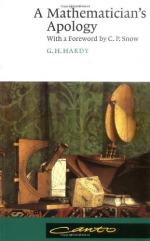|
This section contains 481 words (approx. 2 pages at 400 words per page) |

|
In his review of A Mathematician's Apology in the Spectator, British author Graham Greene asserts that Hardy's philosophy is akin to the philosophy of an artist. "The real mathematician," according to Greene, "must justify himself as an artist." Indeed, Hardy's work is a very successful justification of the mathematician as artist, much in the literary tradition that includes The Autobiography of Benvenuto Cellini; Vincent Van Gogh's letters to his brother Theo; and, as Greene points out, the work of Henry James. Greene writes, "I know no writing—except perhaps Henry James's introductory essays—which conveys so clearly and with such an absence of fuss the excitement of the creative artist."
While the "uninitiated"—that is, non-mathematicians such as Greene—were apt to focus on the work as an artist's memoir, those with more rigorous mathematical training focused on the rift within the...
|
This section contains 481 words (approx. 2 pages at 400 words per page) |

|




